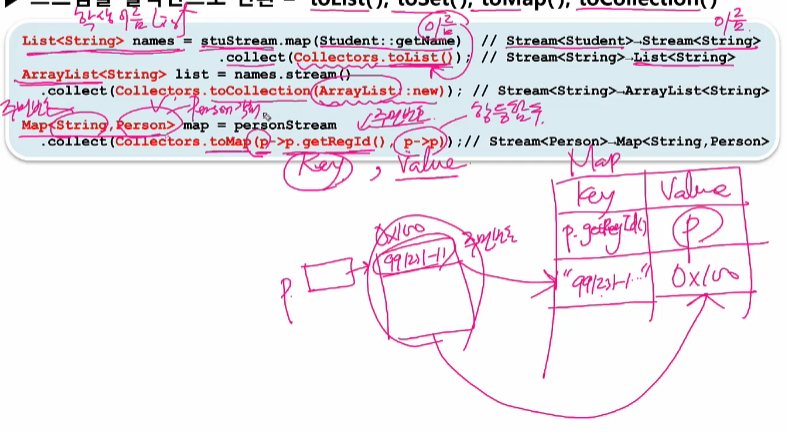collect()
- Collector 인터페이스를 매개변수로 하는 스트림의 최종 연산
Object collect(Collector collector)
Collector collector: collect()에 필요한 메소드를 정의해 놓은 인터페이스
reduce() vs. collect()
공통점
- 리듀싱 : reduce()를 수행한다.
차이점
reduce()
- 스트림 전체를 리듀싱
- 최종 연산
collect()
- 그룹별 리듀싱
Collector 인터페이스
- 수집(
collect())에 필요한 메소드를 정의해 놓은 인터페이스

핵심은 supplier() & accumulator()!!
✨supplier()
- 요소
T를 누적할 곳 ==A
✨accumulator()
- 요소
T를 어떻게 누적할 건지, 누적 수행 작업
combiner()
- 병렬작업에서 각 쓰레드가 작업한 것들을 어떻게 병합할건지
finisher()
T->A->R로 최종변환
characteristics()
- 컬렉터Collector의 특성이 담긴
Set반환
- 그럼 이것들을 우리가 직접 구현해야 하는가?? NO!!!
-> Collectors!!
Collectors 클래스

- 다양한 기능의 컬렉터(Collector)를 구현한 구현체를 제공하는 클래스
스트림을 컬렉션으로 변환
toList(), toSet(), toMap(), toCollection()


스트림을 배열로 변환
toArray() - 매개변수 없는
Student[] stuNames = studentStream.toArray(Student[]::new); //(O)
Student[] stuNames = studentStream.toArray(); //(X)
Student[] stuNames = (Student[])sudentStream.toArray(); //(O)
Object[] stuNames = studentStream.toArray(); //(O)- ✨✨매개변수가 없는 toArray()는
Object[]를 반환한다.
-> 자동형변환을 해주지 않기 때문에 2번이 안된다.
toArray(T[]::new) - 매개변수 있는
Student[] stuNames = studentStream.toArray(Student[]::new); //(O)
Student[] stuNames = studentStream.toArray(); //(X)
Student[] stuNames = (Student[])sudentStream.toArray(); //(O)
Object[] stuNames = studentStream.toArray(); //(O)- 매개변수가 없는 toArray()를 따로 형변환을 해줄 바에야 매개변수가 있는 toArray()로 하는 게 편하다.
- ✨✨매개변수가 있는 toArray()는 매개변수의 타입에 맞춰 반환한다.
스트림의 통계정보 제공
static counting()

- 그룹별 count()
- 여기서
import static java.util.Stream.Collectors.*;로 했기 때문에 Collectors를 생략한 것 - 원래라면
Collectors.counting()이어야 한다.
summingInt()

- 그룹별 sum()
maxBy(), minBy()

- 그룹별 max(비교기준), min(비교기준)
스트림을 리듀싱
reducing()

Collector reducing(T identity, BinaryOperator<T> op)
- 그룹별 리듀싱
BinaryOperator<T> op: accumulator, 누적작업Function<T,U> mapper: T -> U 변환작업- 주로 두번째거!!!



문자열 스트림의 요소를 모두 연결
joining()

